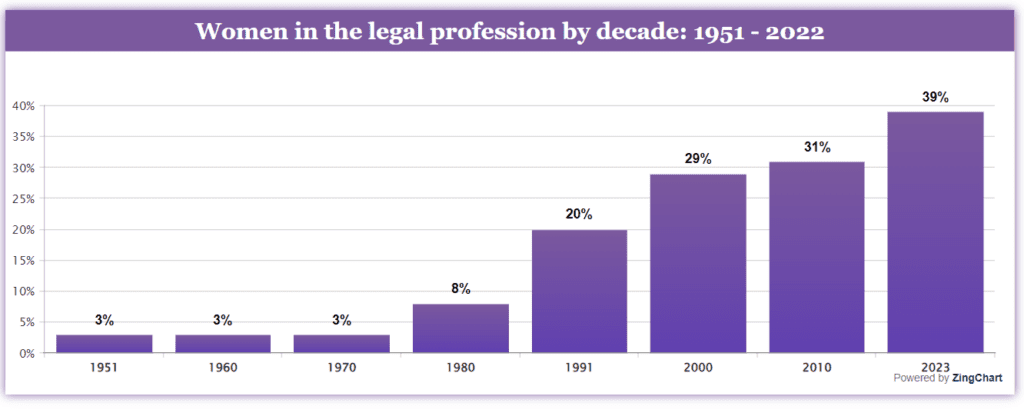In recent years, the legal profession has seen significant strides in advancing gender equality and fostering an inclusive environment for women attorneys. However, challenges persist and the journey toward true equity is ongoing. In this third installment of our women in law series, we dive deeper into the current treatment of attorneys by examining progress made, persisting challenges, and opportunities for further advancement.
Progress for Women in Law:
Since our last update, there have been a few advancements in the representation of women attorneys. According to the American Bar Association (ABA), the percentage of women graduating from law schools continues to rise steadily with women now outnumbering men when it comes to the number of enrollments and graduates of law schools across the US.

This boom of young women lawyers entering the legal field means that women now account for 39% of all US attorneys, compared to 31% in 2010. With women making up 51% of the associates in the US, this progress is expected to continue steadily throughout the next few years.
A notable shift since our original women in law post is the increasing number of women entering prestigious law firms and assuming leadership roles within these organizations. Within the Top 200 law firms of the US, the gap between men and women lateral hires is the smallest it’s ever been. It’s almost non-existent with women making up 48.9% of lateral hires in the Top 200. And finally, there has been a pretty big jump in partner promotions within law firms, increasing to 43% compared to 41% in 2022 and 33% in 2012. This progress shows a positive trend in the ability for women to laterally transition to law firms that offer better opportunities for promotion to partnership.

The continuing advancement of legal technology also means more flexibility when it comes to balancing professional and personal responsibilities, more options for effective mentorship in a remote capacity, and the ability to work at modern firms without the same geographical limitations of traditional law firms.
Arguably, the most impactful progress is heightened awareness and advocacy surrounding issues such as pay equity, promotion opportunities, and the overall treatment of women in law. Many law firms have implemented initiatives aimed at addressing gender disparities in compensation and promoting a more supportive work-life balance for attorneys, regardless of gender. The ABA has continued to provide free resources like the Zero Tolerance Toolkit to help law firms implement change now. These efforts signify a positive shift toward creating a more equitable and inclusive workplace culture.
Challenges for Women in Law:
Despite these advancements, women in law still face significant challenges that hinder their professional advancement and well-being. Gender bias and discrimination remain pervasive in many legal workplaces, manifesting in various forms such as unequal opportunities for advancement, microaggressions, and exclusion from decision-making processes.
Additionally, the retention of women attorneys continues to be a concern for law firms with many experiencing higher attrition rates among female associates compared to their male counterparts. Factors contributing to this phenomenon include lack of mentorship, promotion opportunities, and representation of women at leadership levels. Only 27.76% of partners at US law firms are women and only 23.7% of equity partners are women.
Despite the shrinking gap between genders when it comes to lateral hires at Top 200 firms, most of these lateral hires of women are at the associate level. The path to partnership for women continues to be a pain point for equitable representation within the legal field.
Here are three key issues women in law face for 2024:
- Gender Pay Gap
In a 2023 report, the higher the income bracket, the more likely that attorney is a man. The majority of attorneys that make under $100,000 are women. For each increase in income level of attorneys, the percentage of women earning that level decreases.

- Work-life Balance and Flexible Work Arrangements
It’s been speculated that the reason women leave law is because of their children. In part 1 of our women in law series, we look at the actual data. That data says the number one reason women leave law is a lack of work-life balance. The second most common reason is lack of flexibility in work environment. Staying home with children was one of the least important factors when deciding to leave the practice of law (followed only by the pursuit of another degree).
Just because children aren’t the top reason women are leaving, their feeling of no work-life balance and flexibility might actually stem from the motherhood bias. The ABA discovered that there’s a trend of firms having a negative bias towards women with children compared to men with children, observing:
“Women with children are confronted with unfair and unwarranted criticisms, biases, and stereotypes about their competence and career commitment. This “maternal wall” bias can be triggered when women get pregnant, return from maternity leave, or avail themselves of part-time, flex time, or hybrid work arrangements.”
–ABA Parenthood Report 2023
The reality is today’s tech-forward environment should make it easy… and even the default… to offer all attorneys more work-life balance and flexibility. Even if an attorney is a litigator and still is required to be physically at court, they can have flexibility on their non-court days thanks to legal tech.
- Intersectionality and Diversity
Although most research focuses on gender as the primary identity for women in law, there is growing recognition of the intersecting identities and experiences that shape women attorneys’ professional trajectories. Factors such as race, ethnicity, sexual orientation, and socioeconomic background intersect with gender to influence career opportunities, workplace experiences, and access to leadership positions.
About 17% of law firm associates are women of color but less than 5% of attorneys at the partner level are women of color. This means that attorneys that are women of color struggle to find any representation at the leadership level within firms.
The impact of experiencing underrepresentation at this level is just starting to be researched on a more qualitative level. The ABA and National Native American Bar Association examined the impact of intersectionality and diversity on Native women in law. This quote from the Excluded & Alone report highlights the importance of representation beyond gender alone:
“I was the first in so many places. I was the first Native person that many of my classmates in law school had ever met. I was definitely the first Native lawyer that people at my first job knew. I had to figure out what was possible for a Native lawyer because I didn’t know any. I didn’t really even know if they existed.”
Part 2 of this series discussed how encouraging women to share their experiences and concerns is one of the top ways to foster a culture of diversity and inclusivity. That same step applies to attorneys that come from any underrepresented group, including race, ethnicity, sexual orientation, etc. Without listening and learning from firsthand experiences, it becomes a lot more challenging to implement effective change at your law firm.
What’s next?
Representation within a law firm is crucial because it enables attorneys to fully understand clients’ unique challenges. A team of attorneys from diverse backgrounds results in a team that can relate to their clients and develop unique solutions to complex problems.
Encouraging this diverse representation means cultivating a culture of respect, innovation, opportunity, and openness. Accountability and transparency regarding pay equity and performance evaluations is crucial for ensuring fair treatment and opportunities for all attorneys, regardless of gender. At Practus, we understand we have room for improvement regarding diversity within our firm, and we are constantly re-evaluating our firm’s recruitment practices and outreach when it comes to growing our legal team.
Adopting flexible work arrangements and policies that accommodate the diverse needs of our team is one of the ways we support partners and our non-legal team. We understand that attorneys are people too, which is why we provide our partners with the autonomy and flexibility they need to work their best while also having a personal life. The virtual nature of our firm provides the opportunity to recruit and retain attorneys from around the world, supporting a more diverse environment.
As we reflect on the progress made and the challenges that persist for women in law, there is still much work to be done to achieve true equality in the legal profession. By recognizing and addressing the barriers faced by underrepresented attorneys, and by leveraging opportunities for advancement, we can create a more inclusive and equitable environment where all legal professionals can thrive.
Access the full women in law series:






